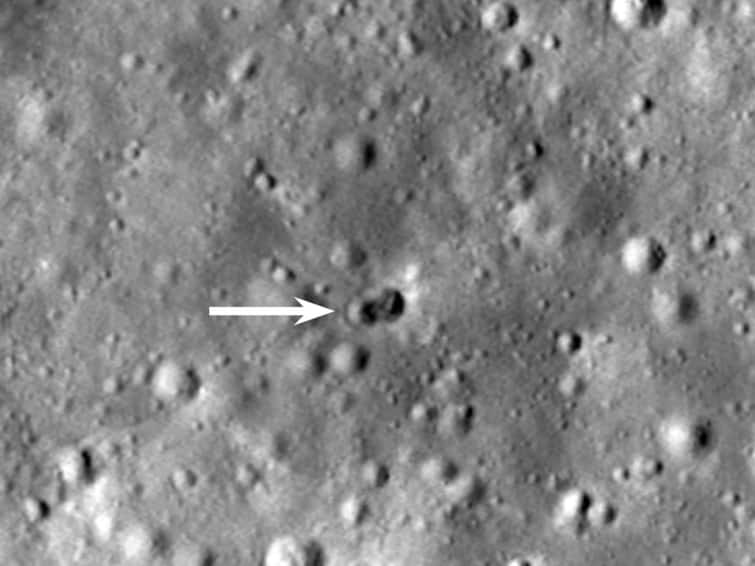
In March of this year, a rocket body collided with the moon. The object was observed heading towards a lunar collision rate last year.
NASA’s Lunar Reconnaissance Orbiter has spotted a crater — actually two craters — on the moon created by the March 4 impact. The fact that the rocket body left a ‘double crater’ suggests it wasn’t your average rocket. Since the rocket crash-landed, none of the space-exploring nations have claimed responsibility for the mysterious projectile. This has left NASA scientists confused as to who was behind the launch.
The mysterious rocket may have had large masses at each end
The eastern crater is 18 meters in diameter and overlies a western crater that is 16 meters in diameter, NASA said on its website.
Astronomers did not expect that the crater would be a double crater. This may have arisen because the “mysterious rocket” had large masses at each end. A spent rocket tends to have mass concentrated at the motor end, while the rest of the rocket stage is mostly an empty fuel tank. The dual nature of the crater could point to the identity of the mysterious rocket.
The mysterious rocket collided with the moon near Hertzsprung Crater, which is an impact crater on the far side of the moon.
Images captured by NASA’s Lunar Reconnaissance Orbiter show that the wayward debris somehow punched out two overlapping craters as it slammed into the far side of the moon at about 9,290 kilometers per hour, according to an article published by LiveScience.
Mysterious object could be part of China’s Chang’e 5‑T1 rocket
Bill Gray, a US astronomer, had predicted that the orbiting piece of space debris would hit the far side of the moon in a matter of months, LiveScience reported.
After first spotting the debris, Gray had suspected it was the second stage of a Falcon X rocket launched in 2015, a spacecraft named after the Chinese moon goddess that was launched in 2014. Chinese officials contradicted the theory, claiming that the rocket’s upper stage burned up in Earth’s atmosphere a few years ago.
Experts have predicted that the discarded rocket stage hit the lunar surface at 7:25 a.m. EST (4:55 p.m. IST) on March 4 at Hertzsprung Crater on the far side of the moon.
According to the LiveScience article, if positioned to capture the impact, NASA’s Lunar Reconnaissance Orbiter would likely have documented a plume of lunar dust hundreds of miles high.
Examination of the craters is unlikely to provide any significant clues as to their disputed origin, as the rocket booster likely completely disintegrated upon impact. After the images were released, Gray wrote on his blog that the object was “pretty positively identified as a Chang’e 5‑TI Booster.”
The mysterious object was first discovered in 2015
In March 2015, Gray made his first prediction that the disputed debris would collide with the moon. This came after the debris was discovered in March 2015 as it tumbled through space.
The mysterious object has been given the tentative name WE0913A. The Catalina Sky Survey, a series of telescopes near Tucson, Arizona, was the first to spot the object. Gray believed the object was man-made because it orbited Earth, not the Sun, unlike an asteroid.
How Chang’e 5‑T1’s upper stage could have created the crater
Gray thought that the upper stage of China’s Chang’e 5‑T1 might have created the crater. The mission was launched in October 2014 as part of an interim mission to send a test capsule to and from the moon. When Chinese Foreign Ministry officials dismissed claims that the space junk was theirs and said the rocket burned up on its return journey to Earth, US experts suggested officials may have linked a similarly-designated rocket from a 2020 mission with the rocket from 2014 might have confused. The experts explained that the 2014 rocket could have hit the moon.
The US Department of Defense Space Command, which tracks space debris in low-Earth orbit, released on Jan.
According to the LiveScience article, Gray said that a ham radio satellite, or CubeSat, was attached to the Chang’e 5‑T1 for the first 19 days of its flight, and the trajectory data returned by that satellite perfectly matches the current trajectory of the missile debris.
NASA Jet Propulsion Laboratory’s Center for Near Earth Object Studies confirmed Gray’s analysis of the orbit data, the article said. Also, researchers from the University of Arizona analyzed the spectrum of light reflected from paint on the crashed debris and identified the missile as part of the Chang’e 5‑T1 mission.
Gray believes space agencies and private companies should develop better ways to track the rockets they send into space, and this would prevent such objects from being confused with Earth-threatening asteroids.
Previous cases of man-made satellites falling on the moon
Although rocket body impacts have occurred on the moon in the past, none have produced double craters. At least 47 NASA rocket bodies have caused “spacecraft impacts” on the moon, according to 2016 data from Arizona State University.
NASA’s Lunar Crater Observation and Sensing Satellite was purposely launched at the moon’s south pole in 2009 at 9,000 kilometers per hour. This released a cloud that allowed scientists to see the chemical signatures of water ice. NASA deliberately crashed the Apollo program’s Saturn V rockets into the moon to dispose of them.
The four craters created by the Apollo S‑IVB stages were somewhat irregular in shape and significantly larger than each of the double craters. These craters were created as a result of the Apollo 13, 14, 15 and 17 missions. The maximum width of the double crater was close to that of the S‑IVBs.










